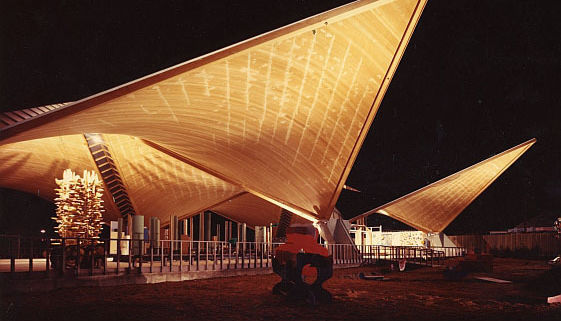John Storrs, Modernist

John Storrs' Lumber Industry Pavilion at the Oregon Centennial was intended to be a permanent display.
In the family tree of architects who’ve created our beloved Northwest Regional modernist architecture, John Storrs (1920-2003) was one of the longest, strongest branches. A Dartmouth grad who got his architecture degree from Yale in 1949, he escaped to Portland shortly thereafter, having been attracted by the work of another Portland immigrant, Pietro Bellushchi. Storrs went on to design some of the second generation of buildings that epitomize the style and character of our region – most notably, Salishan Lodge on the Oregon Coast.
Learn more about Storrs and his work at the Architecture Heritage Center presentation February 16, 2013. Historian and AHC education manager Val Ballestrem will share stories and images culled from his research and that of consulting historian Morgen Young of Alder, LLC. Much of the material is courtesy of Storrs’ widow, Frances, who opened up her boxes of photos and papers to the AHC for development of the program.
Besides Salishan, built for developer John Gray in 1965, and a plethora of residential projects spanning decades, Storrs is also known for the Portland Garden Club on SW Vista (1956), the World Forestry Center in Washington Park (1971), and several original buildings at the Oregon College of Art and Craft (1979). Less known, probably because it is no longer standing, is his Lumber Industry Pavilion built for the Oregon Centennial. Amidst the temporary buildings at that exhibition, the Lumber Pavilion was to be permanent, but ended up being demolished after having lost its elaborate, hyperbolic paraboloid roof in a 1962 storm.
Storrs, with engineer James G. Pierson, employed a similar roof in a second, though humbler building which you may actually have seen if you've ever driven up I-5: "Marineland at Pier 99." It too will be demolished if the Columbia River Crossing project (a.k.a., the long-suffering would-be replacement to the Interstate Bridge between Portland and Vancouver), in its "current" plan, ever gets built. No need to hold breath on that one, of course, but still, go check out the roof while you can. And check out the AHC lecture February 16.
Oenophiles should know that Storrs also designed the Sokol-Blosser Winery in Dundee, and was an accomplished, avid cook; he passed the cooking gene on to his son Leather, who has built a career as a successful chef here in Portland.




